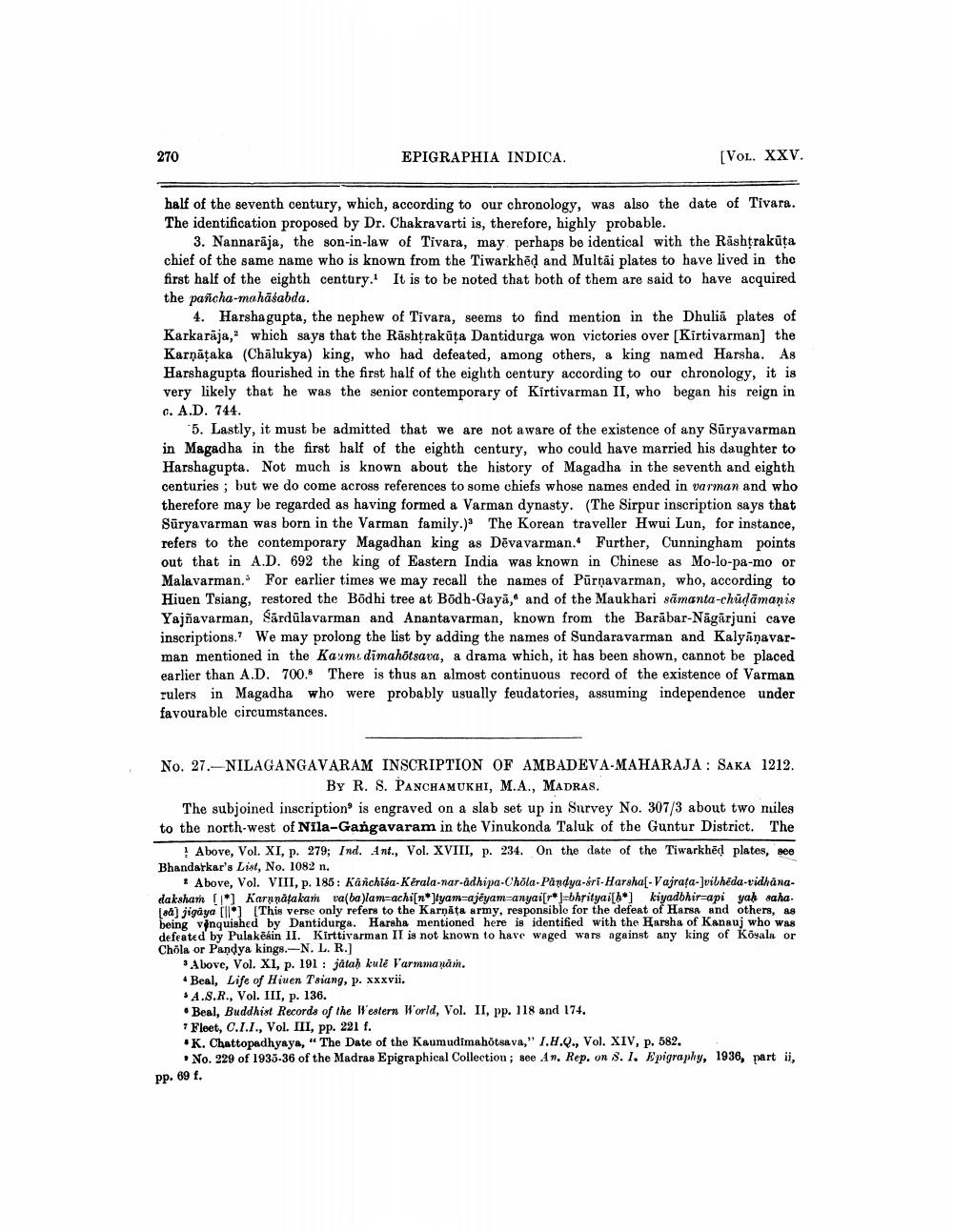________________
270
EPIGRAPHIA INDICA
[Vol. xxv.
half of the seventh century, which, according to our chronology, was also the date of Tivara. The identification proposed by Dr. Chakravarti is, therefore, highly probable.
3. Nannarāja, the son-in-law of Tivara, may perhaps be identical with the Rashtrakūta chief of the same name who is known from the Tiwarkhēd and Multāi plates to have lived in the first half of the eighth century. It is to be noted that both of them are said to have acquired the pañcha-mahāšabda.
4. Harsha gupta, the nephew of Tivara, seems to find mention in the Dhuliā plates of Karkarāja," which says that the Rashtrakūta Dantidurga won victories over (Kirtivarman] the Karņāțaka (Chālukya) king, who had defeated, among others, a king named Harsha. As Harshagupta flourished in the first half of the eighth century according to our chronology, it is very likely that he was the senior contemporary of Kirtivarman II, who began his reign in c. A.D. 744.
5. Lastly, it must be admitted that we are not aware of the existence of any Suryavarman in Magadha in the first half of the eighth century, who could have married his daughter to Harshagupta. Not much is known about the history of Magadha in the seventh and eighth centuries, but we do come across references to some chiefs whose names ended in varman and who therefore may be regarded as having formed a Varman dynasty. (The Sirpur inscription says that Sūryavarman was born in the Varman family.) The Korean traveller Hwui Lun, for instance, refers to the contemporary Magadhan king as Dēvavarman. Further, Cunningham points out that in A.D. 692 the king of Eastern India was known in Chinese as Mo-lo-pa-mo or Malavarman. For earlier times we may recall the names of Pūrņavarman, who, according to Hiuen Tsiang, restored the Bödhi tree at Bödh-Gayā, and of the Maukhari sāmanta-chūdāmanis Yajñavarman, Sārdūlavarman and Anantavarman, known from the Barābar-Nāgārjuni cave inscriptions. We may prolong the list by adding the names of Sundaravarman and Kalyanavarman mentioned in the Kaum, dimahotsava, a drama which, it has been shown, cannot be placed earlier than A.D. 700.8 There is thus an almost continuous record of the existence of Varman rulers in Magadha who were probably usually feudatories, assuming independence under favourable circumstances.
No. 27.-NILAGANGAVARAM INSCRIPTION OF AMBADEVA-MAHARAJA : SAKA 1212.
By R. S. PANCHAMUKHI, M.A., MADRAS. The subjoined inscription is engraved on a slab set up in Survey No. 307/3 about two nuiles to the north-west of Nila-Gangavaram in the Vinukonda Taluk of the Guntur District. The
Above, Vol. XI, p. 279; Ind. Ant., Vol. XVIII, p. 234. On the date of the Tiwarkhed plates, see Bhandarkar's List, No. 1082 n.
. Above, Vol. VIII, p. 186: Kanchida-Kerala-nar-adhipa-Chola. Pandya-sri-Harsha[- Vajrata-Jvibheda-vidhanadakshamn () Karnatakam vaba)lam-achi[n*]tyam-ajêyam-anyai[r*j-bhrityai[l*) kiyadbhir-api yah saha. (aa) jigaya (11[This verse only refers to the Karnāta army, responsiblo for the defeat of Harsa and others, 48 being vanquished by Dantidurga. Harsha mentioned here is identified with the Harsha of Kanauj who was defeated by Pulakēsin II. Kirttivarman II is not known to have waged wars against any king of Kösala or Chola or Pandya kings.-N. L. R.)
3 Above, Vol. XI, p. 191 : jatah kule Varmmaņām. • Beal, Life of Hiuen Triang, P. xxxvii. $ A.S.R., Vol. III, p. 136. • Beal, Buddhist Records of the Western World, Vol. II, pp. 118 and 174. 7 Fleet, C.1.1., Vol. III, pp. 221 f. .K. Chattopadhyaya, " The Date of the Kaumudimahotsava," I.H.Q., Vol. XIV, p. 582. No. 229 of 1935-36 of the Madras Epigraphical Collection; see .An. Rep. on 8.1. Epigraphy, 1936, part ii,
pp. 69 f.




